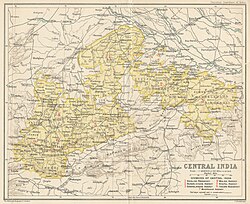Origin and History
The state was founded in 1807 by Thakur Lakshman Singh yadav . He was a chieftain who rebelled against British. When the British took control of Bundelkhand, they asked the rebel chieftains to surrender and put a condition of giving jagirdari in return. He then obtained a charter (sanad) of five villages from the British Raj. [5] He made Naigawan Rebai as the centre of the jagir. He died in 1808 and was succeeded by his son Kunwar Jagat Singh. [6]
Kunwar Jagat Singh
Kunwar Jagat Singh became chief of state in 1808 and was crowned with title of “Sawai”.
In 1850 it was held that Lakshman Singh's tenure was for life only, and that the holding should have been resumed on his death. [7] Jagat Singh was, however, allowed to continue in possession and in 1862 this ruling was reversed and the jagirdar received an adoption sanad.
Kunwar Jagat Singh remained in power till he died in 1867. After that Larai Dulhaiya became the holder of state, she was widow of Jagat Singh, who succeeded in 1867. [7]
Thakurani Larai Dulhaiya
Larai Dulhaiya succeeded in 1867 with the sanction of Government, though no woman had before held the position of ruling chief in Bundelkhand. She had 6 cavalry, 51 foot soldiers and 1 cannon.
In 1893 Larai Dulhaiya adopted Kunwar Viswanath Singh, who was born in 1881 to a distant relative of the Naigawan Rebai Raj family : the adoption was sanctioned by the British Government and his right of succession to Thakurain Larai Dulhaiya was recognised.
Kunwar Vishwanath Singh
Vishwanath Singh succeeded Thakurani Larai Dulhaiya in 1908. He was granted administrative power on the 8 March 1909. Vishwanath Singh expanded the Jagirdari, Now the area of state (jagir) was about 12-25 square miles, which included more than 12 villages and the revenue was Rs. 17,000. Vishwanath Singh married three times, all the three marriages being with the daughters of the Dauwa Ahir family in Sarila. [8] He died on the 1st June 1935 and was succeeded by his adopted son Kunwar Ratan Singh, who was born on the 16th February 1913. [7]
Kunwar Ratan Singh
Kunwar Ratan Singh was most probably the last Jagirdar of Naigawan Rebai state. After the Independence, princely state was merged with Republic of India in 1949. [9]
This page is based on this
Wikipedia article Text is available under the
CC BY-SA 4.0 license; additional terms may apply.
Images, videos and audio are available under their respective licenses.
